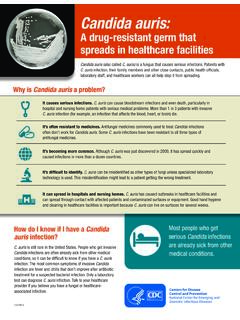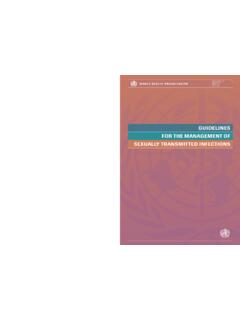Transcription of OSHA INFOSHEET
1 1 OSHA INFOSHEETW here are eyewash stations used? Eyewash facilities are required in workplaces where corrosive chemicals are used (29 CFR (c)), as well as in HIV and HBV research laboratories and production facilities ( (e)(3)(i)), and where there is any possibility that an employee s eyes may be splashed with solutions containing percent or greater formaldehyde ( (i)(3)). They may also be found in research and production laboratories, in medical facilities and other workplaces with materials that may cause injury to or infection of the eyes. How can improperly maintained eyewash stations cause infections ? Water found in improperly maintained eyewash stations is more likely to contain organisms ( , Acanthamoeba, Pseudomonas, Legionella) that thrive in stagnant or untreated water and are known to cause infections .
2 When a worker uses an eyewash station that is not maintained, organisms in the water may come into contact with the eye, skin, or may be inhaled. Workers using eyewash stations after exposure to a hazardous chemical or material may have eye injuries that make the eye more susceptible to infection. Also, workers with skin damage or compromised immune systems ( , transplant recovery, cancer, lupus) are at increased risk for developing illnesses from contaminated water. Early diagnosis is important to prevent infections from causing serious health effects, including permanent vision loss and severe lung diseases ( , pneumonia). The following are a few organisms that thrive in eyewash stations when not maintained properly and the health hazards they present.
3 This list is not all inclusive. There are many other micro-organisms that live in stagnant water that are not listed below. Acanthamoeba is a microscopic single cell organism (amoeba) that may cause eye infections (see Figure 1). This organism can live in treated water and is commonly found in mucous membranes ( , nose, throat, eyes) and in neurological tissues ( , brain) without causing harm to the person. On rare occasions, exposure to Acanthamoeba results in harmful eye infections known as Acanthamoeba keratitis. Along with keratitis, workers with compromised immune systems face a significantly higher risk for developing neurological infections (Granulomatous Amoebic Encephalitis) or whole body infections . Workers may also experience eye redness, pain, tearing, blurred vision, light sensitivity, and eye inflammation several days after the use of a contaminated eyewash station.
4 Diagnosing Acanthamoeba keratitis is difficult because more common eye infections have similar symptoms. Health Effects from Contaminated Water in Eyewash StationsEyewash stations used in workplaces must be maintained to prevent injury and illness to workers. This INFOSHEET provides updated information on eyewash station hazards. Eyewash stations are critical emergency safety equipment intended to mitigate eye injuries when control methods do not prevent exposure to a physical or chemical irritant or a biological agent. The ANSI standard for eyewashes specifies that eyewashes must be capable of delivering tepid flushing fluid to the eyes not less than liters per minute ( gpm) for 15 minutes after a single movement and subsequent hands-free operation.
5 Whether the eyewash station is permanently connected to a source of potable water ( , plumbed) or has self-contained flushing fluid, improper maintenance may present health hazards that can worsen or cause additional damage to a worker s 1. Left, broad illumination; right, slit beam illumination. Early epithelial stage. Multifocal intraepithelial Acanthamoeba courtesy of Dan B. Jones, infections are typically caused by a common bacteria species. Pseudomonas aeruginosa may cause infections to eyes, skin, muscle, lung, and other tissues. One symptom specific to Pseudomonas aeruginosa infection is green-blue pus in or around the infected area. If a pseudomonas infection spreads through the bloodstream ( , septicemia), workers may become very sick with fevers, chills, confusion, shock, and even death.
6 This bacterium has developed resistance to many antibiotics, which may make it harder to is a group of bacteria that are found in nature living with amoeba and may cause a serious lung infection. For example, since Acanthamoeba are effective hosts for Legionella, they may both be present in contaminated water. Although Legionella does not cause eye infections , inhaling water droplets containing the bacteria can cause Legionnaires disease, a severe and fatal form of pneumonia. Workers with compromised immune systems, workers over the age of 55 or those with pre-existing lung diseases, such as Chronic Obstructive Pulmonary Diseases (COPD) are more at risk for infection. Legionnaires disease symptoms occur 2 to 14 days after exposure, including coughing, breathlessness, high fever, muscle aches, and headaches, often requiring more information on Legionnaires disease visit the OSHA Safety and Health Topics Page ( ).
7 How can eyewash stations be maintained to prevent infections ? Eyewash station manufacturer instructions provide direction on how often and how long to activate specific plumbed systems to reduce microbial contamination and generally reference the American National Standards Institute (ANSI) standard Self-contained eyewash units must be maintained and employers should consult the manufacturer s instructions for maintenance procedures. This includes flushing the system and using only solutions appropriate for flushing RightsWorkers have the right to: Working conditions that do not pose a risk of serious harm. Receive information and training (in a language and vocabulary the worker understands) about workplace hazards, methods to prevent them, and the OSHA standards that apply to their workplace.
8 Review records of work-related injuries and illnesses. File a complaint asking OSHA to inspect their workplace if they believe there is a serious hazard or that their employer is not following OSHA s rules. OSHA will keep all identities confidential. Exercise their rights under the law without retaliation, including reporting an injury or raising health and safety concerns with their employer or OSHA. If a worker has been retaliated against for using their rights, they must file a complaint with OSHA as soon as possible, but no later than 30 days. For additional information on Workers Rights, Employer Responsibilities, and other services OSHA offers, visit OSHAFor questions or to get information or advice, to report an emergency, fatality, inpatient hospitalization, amputation, or loss of an eye, or to file a confidential complaint, contact your nearest OSHA office, visit , or call OSHA at 1-800-321-OSHA (6742), TTY 1-877-889-5627.
9 OSHA s On-site Consultation Program offers free and confidential advice to small and medium-sized businesses in all states across the country, with priority given to high-hazard worksites. On-site consultation services are separate from enforcement and do not result in penalties or citations. For more information, to find the local On-site Consultation office in your state, or to request a brochure on Consultation Services, visit , or call 1-800-321- OSHA (6742).Many states operate their own OSHA-approved safety and health program. For further information, please visit 2. Eyewash with protective found in eyewash stations: Paszko-Kolva C et al. Isolation of amoebae and Pseudomonas and Legionella spp. from eyewash stations. Applied and Environmental Microbiology.
10 1991;57(1):163 167. [PMC free article] [PubMed]Acanthamoeba and Acanthamoeba Keratitis (AK):Crum-Cianflone NF. Acanthamoeba (updated 7/25/2013) #a0199 Marciano-Cabral F, Cabral GA. Acanthamoeba spp. as agents of disease in humans. Clin Microbiol Rev. 2003;16:273 307. [PMC free article] [PubMed]Contact lens statistics on Acanthamoeba Keratitis (AK):Ibrahim YW, Boase DL, Cree IA. How Could Contact Lens Wearers Be at Risk of Acanthamoeba Infection? A Review. J Optom. 2009;02:60-66. MA, Mathers WD. Acanthamoeba Keratitis: A 12-Year Experience Covering a Wide Spectrum of Presentations, Diagnoses, and Outcomes. Journal of Ophthalmology. rates of AK: Estimated Burden of Keratitis United States, 2010 November 14, 2014 / 63(45);1027-1030 Outbreak of Acanthamoeba Keratitis Associated with Use of a Contact Lens Solution, United States.












